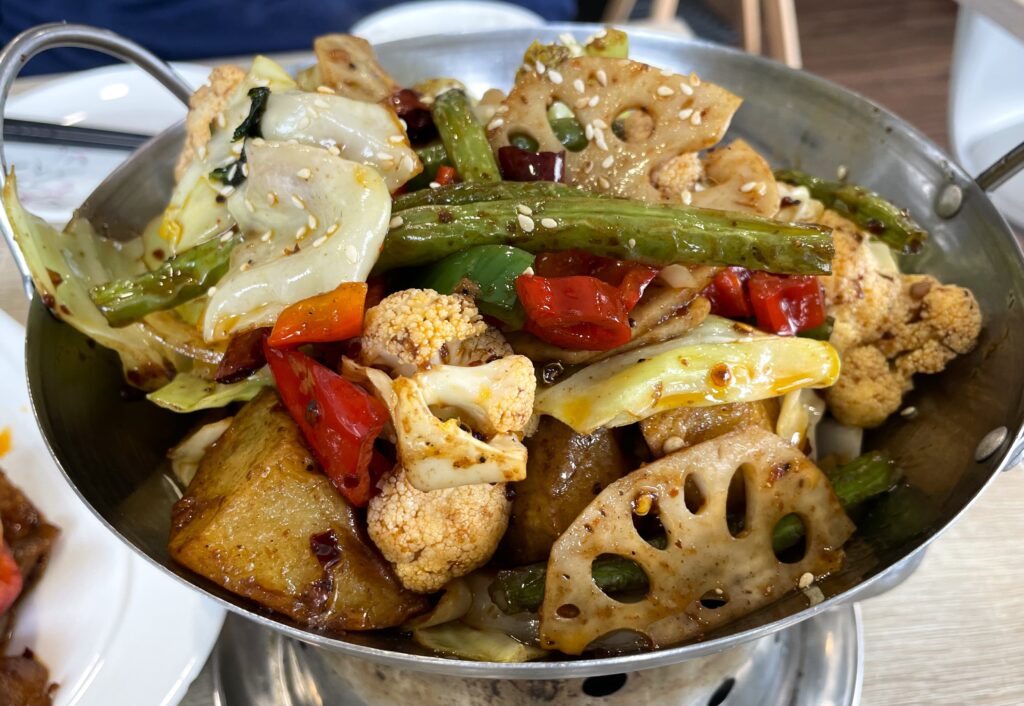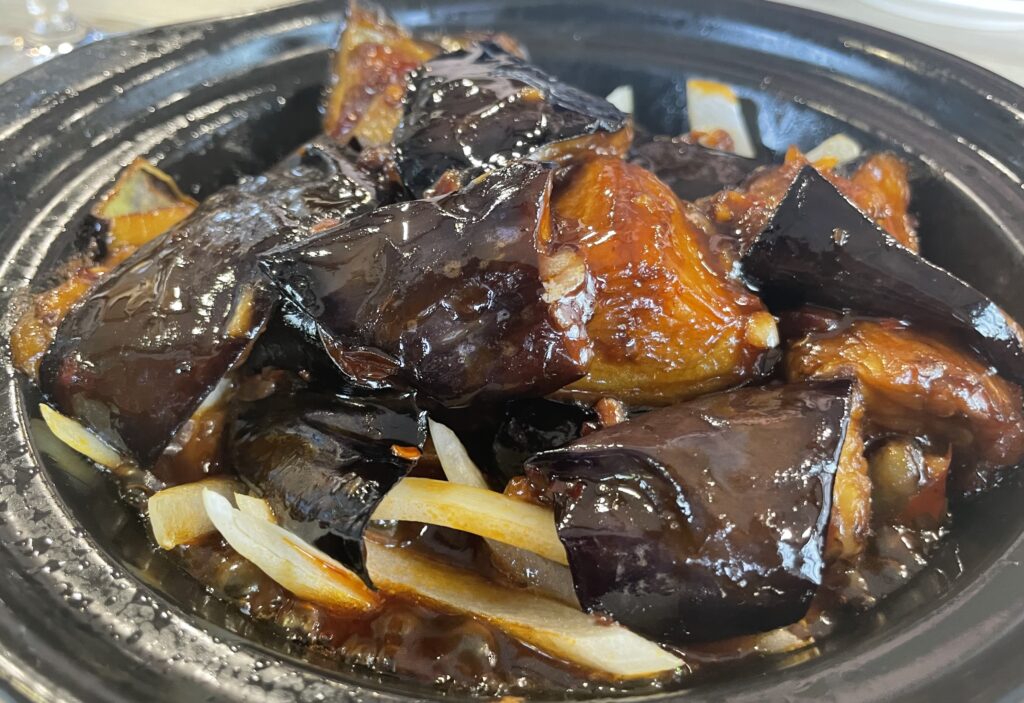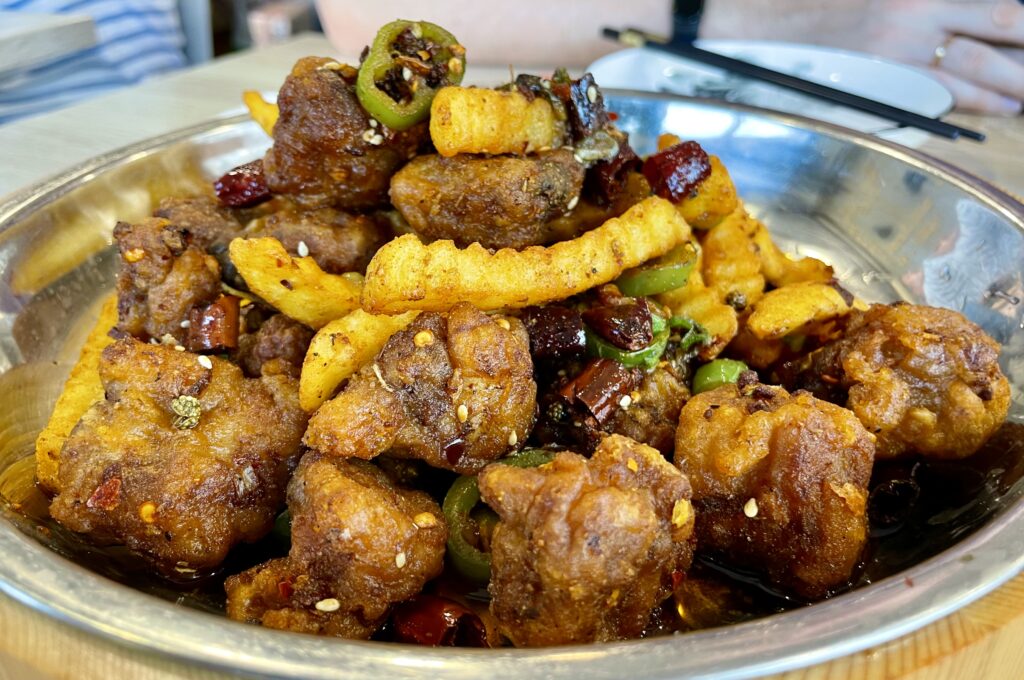Here’s to something new at China Haus 小食代 in Frankfurt! Some time ago we introduced the delicious lamb pot (羊肉锅, Yang Rou Guo) from this restaurant. The combination of tender lamb and a tasty broth makes this dish so special and gives us a feeling of warmth and comfort, especially on cold, grey winter days. But winter is long gone and China Haus has much more to offer. From fresh stir-fried vegetables to wonderfully fragrant fish to crispy fried pork ribs, there is always something for Chinese food lovers.
Like many authentic Chinese restaurants, China Haus specialises in Sichuan cuisine, arguably the most popular and legendary cuisine in the country. In this article, we would like to give you some tasty recommendations on what to order at China Haus.
Restaurant Profile
- Name of the Restaurant: China Haus 小食代
- Adress: Schloßstraße 52, 60486 Frankfurt am Main
- Style: Chinese Cuisine – Sichuan
- Price: around 15 – 25 EUR per Person (incl. Drinks and Tips)
As keen readers of this blog will already know, this province is best known for its spicy flavours. But Sichuan cuisine has much more to offer, and in addition to the usual spicy dishes, we would like to introduce you to some truly delicious dishes that are milder.
So let’s waste no time and get started!
Double-cooked pork, known in Chinese as 回锅肉 (Huí Guō Ròu), originated in Sichuan cuisine. The name literally means “back into the pot”, reflecting the process by which pork belly is first cooked and then stir-fried in a hot pan or wok.

This dish uses thinly sliced pork belly, which is known for its rich flavor due to its high fat content and marbling. It’s cooked with onions and peppers in a spicy, tangy sauce made from fermented beans, garlic, ginger and chilli.
The onions add a subtle sweetness that complements the colourful peppers, which provide a delicious crunch that contrasts beautifully with the tender pork.
干锅蔬菜 (Ganguo Shūcài) literally means ‘dry vegetables in a pot’ and is characterised by an aromatic mixture of vegetables (and sometimes meat, tofu or seafood). We ordered the vegetarian version. At the China Haus it includes cauliflower, onions, potatoes, green beans, lotus root, bell peppers and cabbage.

The dish is served in a hot pot with a small indentation where a candle is placed as a heat source to keep the dish warm until the last bite. The combination of vegetables gives the dish a unique flavor and texture. Tender yet crunchy cauliflower, pleasantly sweet onions, crunchy fresh green beans and lotus roots, bell peppers that add a hint of heat and vibrant colour, and cabbage that rounds out the dish with its mild aroma. Potatoes provide the necessary calories to make the dish satisfying and filling.
The vegetable pot is finished off with chilli and sesame seeds, which not only add an intense flavour, but also an attractive appearance to the dish.
Here is a dish with an unusual presentation – 纸包鱼 (Zhǐbāo Yú), which translates as “fish wrapped in paper”.

As the name suggests, the fish is wrapped in paper with various spices such as garlic, ginger, soy sauce, chilli and vegetables, and then gently steamed or fried. This keeps the fish tender and juicy, and the flavours of the spices blend perfectly with the aroma of the fish. To serve, the fish is garnished with fresh coriander, crisp spring onions and hot chilli peppers, which add a refreshing fragrance and tingling spice. Vegetables such as cauliflower and tofu are served as side dishes.
Dry-fried shrimps, Chinese 干锅虾 (Gānguō xiā) originates from China’s Sichuan province. Fresh prawns are served in a hot pot with a variety of spices, including dried chillies, Sichuan peppercorns, garlic, ginger and spring onions. Similar to the previously introduced Gānguō Shūcài, a candle under the pot keeps the dish warm. Potatoes and vegetables such as celery, onions, peppers and cabbage are also added to add texture and flavour.

The special feature of this dish is the “gānguō” method of preparation: the ingredients are first briefly dry-fried in a hot wok (i.e. without adding any liquid), then added to the pot and cooked. This keeps the prawns tender, while allowing the spices to release their full flavor.
“Eggplant with Fish-Fragrance“, Chinese – 鱼香茄子 (Yúxiāng Qiézi), is a dish from Sichuan province that, despite its name, does not contain fish. Fish fragrance or fish flavor refers to the special blend of spices traditionally used in Sichuan cuisine for fish dishes. This mix consists of garlic, ginger, spring onions, doubanjiang (fermented bean paste), soy sauce, vinegar, sugar and dried chilli peppers.

The main ingredient, eggplant, is cut into finger-length pieces and fried until soft on the inside. The eggplant pieces are then mixed with the spice mix and the onions are tossed in the pan until they have fully absorbed the flavors. The result is a harmonious blend of sweet, sour, and salty.
Note: The spice mix is much milder than what you would typically expect from Sichuan cuisine (e.g. mala) – ideal for those who do not like very spicy food.
The next dish lives up to its name: spicy wok, known in Chinese as 麻辣香锅 (Málà Xiāngguō), is characterized by its intense heat and spiciness. Originating from the Sichuan and Hunan regions, it combines a variety of ingredients such as meat, seafood, vegetables and tofu, all cooked in an aromatic oil made from Sichuan peppercorns and dried chilies. The name is composed of “麻” (má) for numbing spice, “辣” (là) for pungent heat, and “香锅” (xiāngguō) for fragrant pot. Málà Xiāngguō is popular not only for its distinctive “Sichuan flavor” but also for its flexibility in preparation, as the ingredients can be varied according to taste. It is an excellent example of the diversity and richness of Chinese cuisine.

Like some of the dishes described above, málà xiāngguō is served in a hot pot with an additional heat source (candle). This concept runs like a red thread through the menu of the China Haus Restaurant in Frankfurt.
One of the absolute classics of Sichuan cuisine is 麻婆豆腐 (Mápó Dòufu), which is not only well-known and popular in China, but has also gained international recognition.

Its history is particularly interesting: Mapo tofu dates back to the 19th century and was named after the wife of a restaurant owner in Sichuan, who was nicknamed “Ma Po”, meaning “old woman with pockmarks”.
The main ingredients are diced tofu, ground meat (usually pork or beef), fermented black beans, chili bean paste (doubanjiang), and Sichuan peppercorns. Mapo tofu has a rich umami flavor profile created by the combination of spicy, savory, and slightly tangy flavors.
狼牙排骨 (Lángyá Páigǔ), translated as “Wolf Fang Ribs”, are tender and crispy pork ribs marinated in a spicy sauce and then fried. The marinade is typically a mixture of soy sauce, garlic, ginger, Shaoxing rice wine and various spices. The name refers to the special preparation method, in which the ribs are cut in such a way that they resemble wolf fangs.

The preparation of Lángyá Páigǔ requires skill and care to ensure that the ribs become crispy and absorb the full flavor of the sauce. The ribs are sprinkled with sesame seeds and garnished with small French fries and chili.
Another Sichuan dish, 鱼香肉丝 (Yúxiāng Ròusī), consists of thinly sliced pork cooked with mushrooms, bamboo shoots, and bell peppers in a spicy sauce.

The name of the dish, which literally translates as “fish-flavored pork“, is somewhat misleading because, like the previously introduced eggplant dish, it contains no fish. This dish also uses the special seasoning sauce made from fermented chili beans, garlic, ginger, scallions, soy sauce, vinegar and sugar. This unique combination gives the dish its characteristic sweet, sour and salty flavor.
Note: A slightly milder “fish fragrance seasoning mix” is used here, similar to the eggplant dish introduced earlier.
One of my all-time favorite dishes that I used to eat regularly in China is 番茄炒鸡蛋 (Fānqié Chǎo Jīdàn). It consists of sliced tomatoes and scrambled eggs stir-fried together in a frying pan.

First, the scrambled eggs are cooked in the pan, then taken out and the previously chopped tomatoes are stir-fried until they are soft and have released their juice. Then the scrambled eggs are added, everything is mixed well and seasoned with salt and sugar, as well as spring onions and garlic.
Scrambled eggs with tomatoes are light, nutritious, easy and quick to prepare and very tasty. It is an excellent side dish to other authentic Chinese dishes with fish, meat or vegetables.
Note: This dish is suitable for those who do not like it too spicy.
青椒肉丝 (Qīngjiāo Ròusī) consists of thinly sliced pork and green pepper. The name is composed of the words “青椒” (green pepper) and “肉丝” (meat strips). The dish is known for its simple preparation and balanced flavor, which comes from the combination of tender pork and crunchy vegetables.

The pork is cut into fine strips and stir-fried in hot oil until tender and juicy. The green peppers are also cut into strips and stir-fried with the meat in the pan. The dish is seasoned with soy sauce, rice wine, and often a little sugar to achieve a balanced sweet and salty flavor with a slight spiciness.
In each of the above dishes, rice is served as the carbohydrate base, ideal for balancing the flavors of Sichuan and absorbing the heat and oil. I hope you enjoy our little compilation of dishes from China Haus – feel free to leave a comment below.





Tried the tofu and tomato dishes mentioned here. Were amazing! Thank you!
We visited this place recently and really enjoyed the food—it’s got some great dishes. However, with Chinese New Year coming up, be prepared for it to get pretty packed. Expect loud, lively big groups and a bit of chaos – part of the festive vibe!
The food was tasty and authentic overall, but not every dish is good. Many dishes can be heavier on the oil than necessary. The restaurant is quite small and always busy—so definitely book a table in advance. It’s pretty loud inside, but the food arrives quickly hot, which is good. It’s a decent Chinese spot, but there are definitely better ones in Frankfurt where you can enjoy a more relaxed meal.
I am not a super expert on Chinese food, but without a doubt the dishes here are very tasty. I second the recommendations of the pork belly and tofu dishes, very delicious and well presented. The staff is very friendly, helpful and very willing to accommodate all requests. The place is always very crowded, especially with Asian people, confirming the quality. But I recommend booking in advance to reserve a table.
Great food and super friendly staff!